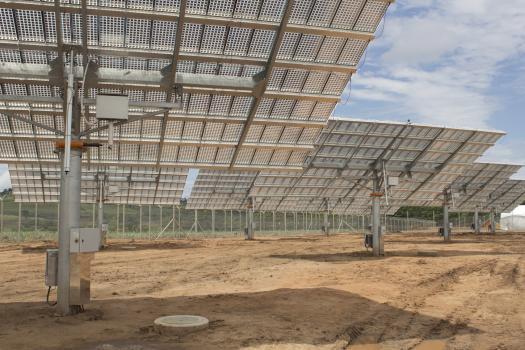Lights out for CPV?

What does Soitec's decision to exit CPV mean for the rest of the industry, asks Compound Semiconductor.
Despite its re-focus on electroncis materials, Soitec has installed more CPV modules than most.
As the dust settles on Soitec's recent decision to distance itself from concentrated photovoltaics and re-focus on electronic materials, industry players are mulling the impact on the costly world of CPV.
France-based Soitec, a consistent leader in CPV development, had set a record-breaking 46% solar cell efficiency and was one of the sector's highest hopes for commercialisation.
Its 44MW Touwsrivier project in South Africa was one of several big wins in recent years that fuelled analysts buoyant predictions of rapid market expansion through to 2020. But, as the price of rival silicon cells has plummeted, Soitec, and the industry has struggled.
In April last year, Soitec revealed independent US energy company, Tenaska, had ditched plans to use the CPV developer's technology at its planned 150MW California PV power plant, choosing more conventional and cheaper PV modules instead.
Then, come December, US utility San Diego Gas & Electric, which had agreed to buy the power generated at the California plant, terminated its business relationship with Soitec and shares sank to an all-time low.
The company's latest 'strategic re-focus' not only brings job cuts at Soitec's San Diego CPV module production plant, but sees industry analysts trimming CPV industry forecasts.
Just days before Soitec's New Year bombshell, US-based industry analyst firm, IHS, predicted CPV would experience accelerated growth of 37% in 2015 bringing some 250 MW in new installations.
IHS solar research analyst, Karl Melkonyan, says the news shifts his company's outlook back by around a year, as predictions had included many of Soitec's projects. But, crucially, he doesn't expect any significant long-term effects.
"Of course this announcement negatively affects our projections, and perhaps investment will slow down," he says. "But CPV is an established technology and it doesn't mean we will see any mid- or long-term damage to the industry."
![]() Soitec achieved a module efficiency of 32.8% with its highly efficient multi-junction solar cells.
Soitec achieved a module efficiency of 32.8% with its highly efficient multi-junction solar cells.
Pointing to very recent market developments, such as Portugal-based MagPower tying up with France-based Heliotrop to form a European CPV consortium, he says: "The CPV market is still in its early phases of growth, and the supplier base will continue to change over the next five years."
"This alliance between MagPower and Heliotrop is a good example of this, and can help CPV technology find the path to a breakthrough," he adds.
Indeed, Melkonyan cites MagPower as just one CPV developer to watch with others including China's leading light, Suncore, Semprius, US, and Spain-based Abengoa Solar.
"Progress will continue," he says. "Semprius is developing a new four-junction cell... Abengoa is ready to build CPV plant. [The sector] is depending on good orders and investment, this will come with time."
But what next for Soitec? Once industry has adjusted to the company's re-focus, Melkonyan is hopeful, as he puts it: 'a company with a large balance sheet' will step in.
Pointing to partnerships between Middle East investors and CPV players, such as Enertech, Kuwait, and Morgan Solar, Canada, as well as Saudi-based KACST and Solar Junction, US, he says: "This is a good opportunity for, maybe an oil company, to either partner with Soitec or acquire [its assets]."
As he adds: "Soitec's technology is established with competitive prices and good manufacturing... this could be an even better opportunity."
For its part, Soitec hasn't announced a firm plan of action. Following its initial cull of 100 employees at its manufacturing facility in San Diego, further cost-cutting and restructuring measures are expected.
But in its last conference call, Soitec executives certainly emphasised that its solar cell technology is mature and ready for large-scale production, a fact that can only offer investor appeal.
And with CPV installations in 14 countries, including the 44MW Touwsrivier project, under development, it's clearly not yet lights out for the company. "Soitec's solar [business] is still working, it hasn't shut down," asserts Melkonyan. "The company has reduced two to three of the production lines it had in the US and will complete remaining orders."
"This is still a lot of installations compared to competitors so the company must be looking for a good partnership with a larger business," he adds.































